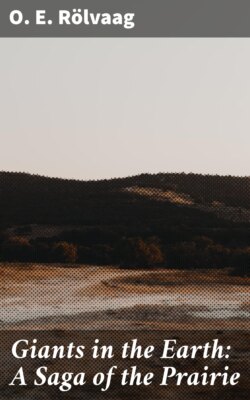Читать книгу Giants in the Earth: A Saga of the Prairie - O. E. Rölvaag - Страница 7
На сайте Литреса книга снята с продажи.
IV
ОглавлениеTable of Contents
I have mentioned the Amerika-Breve, published in 1912. There is an earlier work, still in manuscript--a novel written during his senior year at St. Olaf College. In all, Rölvaag has published six novels, two readers for class use, a couple of handbooks on Norwegian grammar and declamation, and one volume of essays. In 1914 appeared his second book, Paa Glemte Veie (The Forgotten Path), a relatively unimportant product. Then came the war, which threw consternation into all creative work. Rölvaag walked the hills of southern Minnesota, his mind a blank, facing the downfall of civilization, seeing the death of those fine, things of life which he had striven so hard to attain. It was during the war period that he compiled his readers and handbooks, for the publishing board of the Norwegian-American Lutheran Church.
He had married in 1908. In 1920 a tragedy occurred in his family--one of his children was drowned under terrible circumstances. This seems to have shaken him out of the war inertia and stirred his creative life again. That year he wrote and published his first strong novel, To Tullinger (Two Fools), the story of a rough, uncultivated couple, incapable of refinement, who gain success in America and develop the hoarding instinct to a fantastic degree. This book, too, made a sensation among Norwegian-Americans.
Then, in 1922, came Laengselens Baat (The Ship of Longing), which seems to have been Rölvaag's most introspective and poetical effort up to the present time. It is the study of a sensitive, artistic youth who comes to America from Norway full of dreams and ideals, expecting to find all that his soul longs for; he does not find it, with the result that his life goes down in disaster. Needless to say, this book was not popular with his Norwegian-American audience. The truth-teller of To Tullinger was now going a little too far.
All of these works were written and published in Norwegian. They were brought out under the imprint of the Augsburg Publishing House, of Minneapolis, and circulated only among those Norwegian-Americans who had retained the language of the old country. The reason why none of them had reached publication in Norway is characteristic. In 1912 the manuscript of Amerika-Breve had been submitted to Norwegian publishers. They had returned a favourable and even enthusiastic opinion, but had insisted on certain changes in the text. These changes Rölvaag had refused to concede, feeling that they marred the artistic unity of his work. In anger and disappointment, he had at once published with the local house; and with each successive volume the feeling of artistic umbrage had persisted--it had not seemed worth while to try to reach the larger field.
But in the spring of 1923, an item appeared in the Norwegian press to the effect that the great novelist Johan Bojer was about to visit the United States, for the purpose of collecting material on the Norwegian-American immigration. He proposed to write an epic novel on the movement. This news excited Rölvaag tremendously; he felt that the inner truth of the Norwegian-American immigration could be written only by one who had experienced the transplanting of life, who shared the psychology of the settlers. His artistic ambition was up in arms; this was his own field.
He immediately obtained a year's leave of absence from St. Olaf College, and set to work. The first few sections of Giants in the Earth were written in a cabin in the north woods of Minnesota. Then he felt the need of visiting South Dakota again, to gather fresh material. In midwinter of that year he went abroad, locating temporarily in a cheap immigrant hotel in London, where he worked on the novel steadily. When spring opened in 1924, he went to Norway. There he met Bojer, visiting him at his country home. Bojer was delighted to learn that Rölvaag, of whom he had heard a great deal, was also working on a novel of the Norwegian-American settlement; the two men exchanged ideas generously. "How do you see the problem?" Rölvaag asked. The answer showed him that Bojer saw it from the viewpoint of Norway, not of America; to him it was mainly a problem of emigration. This greatly relieved Rölvaag's mind, for there was no real conflict; he set to work with renewed energy, and soon finished the first book of Giants in the Earth.
In the meanwhile it had been placed with Norwegian publishers--the same firm, by the way, which had lost Amerika-Breve twelve years before. It appeared in the latter part of 1924, under the title I De Dage (In Those Days), a month in advance of Bojer's Vor Egen Stamme (Our Own Tribe), better known to us by its English title of The Emigrants. A year later the second book of the present volume was brought out, under the title Riket Grundlaegges (Founding the Kingdom).
In Norway these two books have run through many editions; they have been hailed on every hand as something new in Norwegian literature. Swedish and Finnish editions will be published in 1927. Arrangements are being made for a German translation, and the book will probably be off the press in Germany soon after it has appeared in the United States. Rölvaag's vigorous, idiomatic style (which, incidentally, has been the despair of those who have worked over the English translation) is an outstanding topic of recent Scandinavian criticism. The eminent Danish critic, Jörgen Bukdahl, for instance, in his latest work, Det Skjulte Norge (The Latent Norway), devotes a whole chapter to Rölvaag and his novels of pioneering in South Dakota. A new name has been added to the literary firmament of Norway.
